It seems theres still a few of these large process cameras out there. Heres a few people that I’ve been in touch with the last few months.
Rajesh Soni – India
Rajesh is an artist who belongs to a family of traditional photographers and photo-hand colourists associated with the Royal Court of the Maharaja Bhopal Singh of Mewar. He contacted me after searching for info on the HP camera, he still has his Grandfathers 20×24 camera.

Rajesh (left) and his brother with their Grandfathers camera.
Peter Thomas – Exeter, UK
Peters camera is currently on loan to the Plymouth School of Art, it has been used by students to shoot paper and film negatives. Some of those students have gone on to build their own ultra large format cameras.
Peter saved his 20×24 camera from a printers in Exeter where they were about to put a sledge hammer to it!
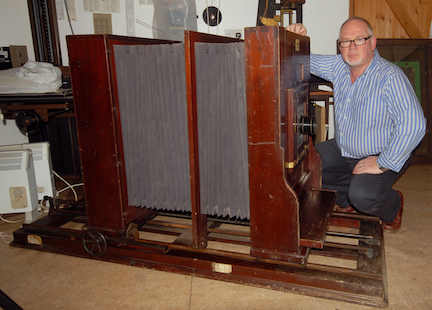
Alice Blanch – Australia
“Apparently this camera has been around the uni for 10 years and no one ever bothered to see what they could do with it. We have asked around the photography department and no one seems to even know how it got here. Its completely weird but completely amazing that we have the chance to use such a camera. Id say there are only a few of these sorts of cameras left in the world and even less in Australia.”
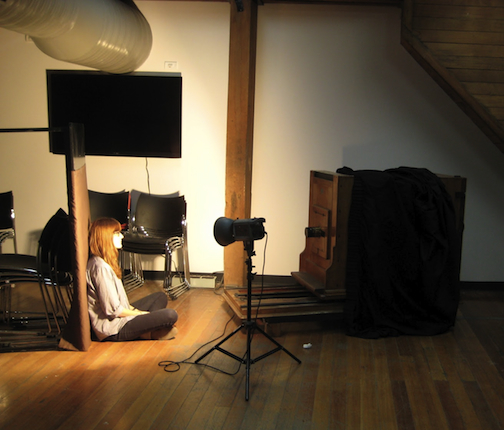
Check out Alices website and blog, she does some amazing work.
Alices blog post
Angela Wachsmann – Texas, USA
Angela contacted me to see if her camera could still be used to take photographs. She works at the Re-union Grille, Cedar Park, Texas. The camera is part of the fixtures and fittings of the restaurant but they are looking at getting it up and running in the near future. Any of my US friends like to drop by and take a look?

Peter Defty – Leeds, UK
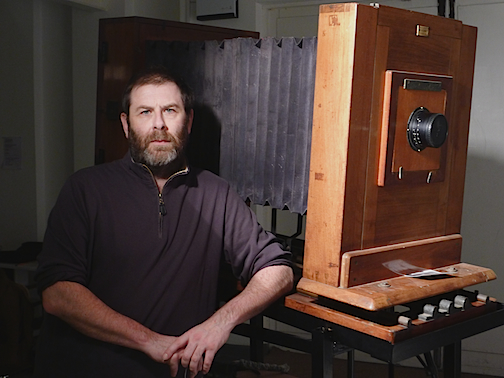
Peters process camera, is a little different as its made by Sidney R. Littlejohn Co. (circa 1927), was brought back to life and converted to shoot 5”x4”, 5’x7”, 10”x 8” and 14”x17” sheet film, with Ilford FP4 being the stock of choice across the formats, though with further development, it will be possible to shoot 20”x24” film, glass and paper negatives.
Check out this excellent Vimeo clip highlighting The Outlaw Project…
The Outlaw Project from Slaughterhouse Studios
Dan Kennedy & Nicole Truax – Boston USA
“We have one (20×24) here in Boston, it was loaned to us and belongs to Francesco Dimitri Fragomeni and we’re currently using it for an ongoing wet plate project.”
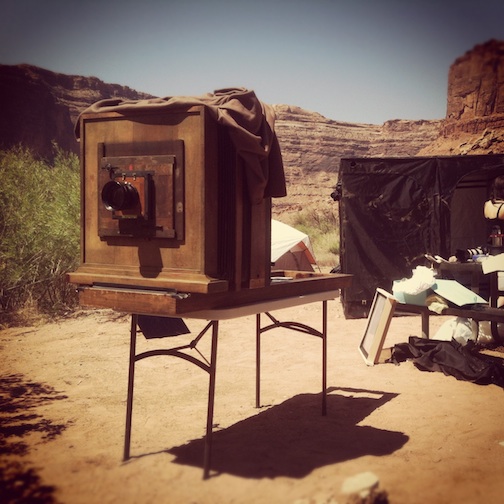
Francesco Dimitri Fragomeni – “It was originally a R.R. Robertson copy camera built in Chicago around 1915-1920. When new, it was set up on a 20 foot rail system in the basement of a museum and used to make photographs of the museum’s collection. I’ve never been able to figure out which museum but this was usually the primary use for these cameras when new and they were usually made to order for museums. When the museum replaced the camera, it was given to a portrait photographer who removed it from the original rail system and made the first modifications to the camera for use in a portrait studio. For this particular camera, that studio is believed to have been in NM.
After some time the studio closed and the camera was disassembled and stored. At some point, someone discovered the camera and reassembled it (improperly) probably for use as a prop or decoration in a store front. Eventually, it was partially disassembled again and stored until it was found by the man I bought it from who moved it to the back of an antique shop in Scottsdale, AZ which is where I came upon it. I bought the camera and reassembled it properly and removed about 100lbs of unnecessary iron parts. Then I gave it to Dan.”

A new addition (I’ll add them as people send me their info)
This is Kelly Shane Fuller with his Robertson Model Seventeen process camera. Kelly says ” Its a 14×17 with a 20×24 expansion back on it rocking a 14in Artar. I don’t know much about it’s history, but got it from a very old man in Seattle. He said it came out of a copy shop in the 40’s, and he’s had it ever since.”
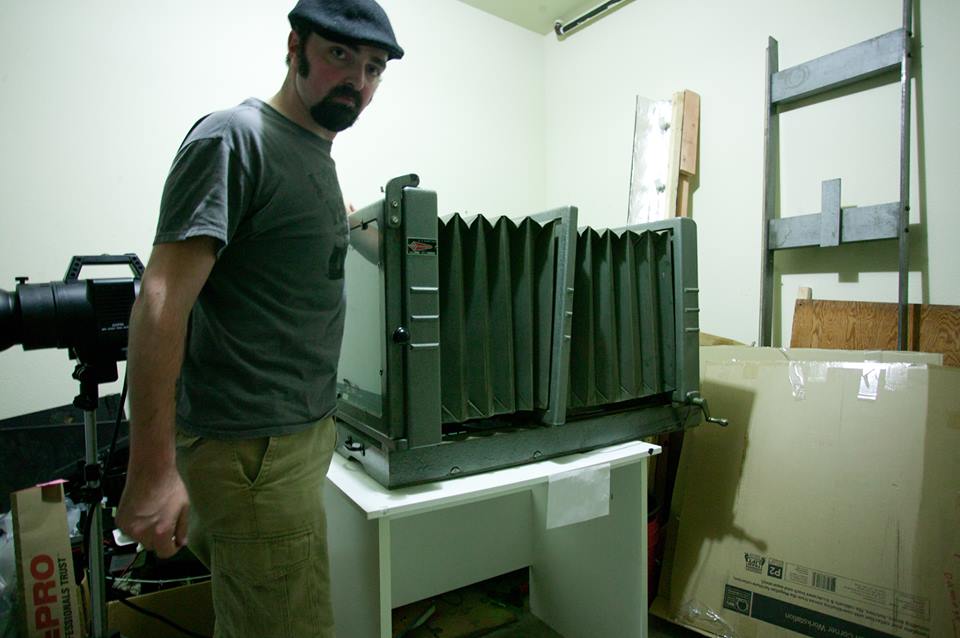
Oh and I forgot to post one of me with my Hunter Penrose…

A bit of history… from the Hunter Penrose website.
“The year 2013 marks the 120th anniversary of the founding of our business in the printing industry. Hunter Penrose traces its roots back to A W Penrose & Co which started a ‘Process Chemicals Stores’ in Upper Baker St, London in 1893 as a branch of a pharmaceutical chemical company formed in the 1830s.
A W Penrose grew rapidly with the then newly emerging process engraving industry which mushroomed to incorporate photographically produced chemically etched halftone blocks instead of hand drawn engravings. A key item of equipment for newspapers and printers rapidly became the process camera and, within a few years of its foundation, Hunter Penrose was selling these all round the world. Click here for information on Penrose cameras
Arthur Wellesley Penrose was born in 1873 and was a surgeon, when he founded the process stores with William Gamble and A Wybrant in 1893. They established the business using premises owned by Mr Penrose’s grandfather, also an Arthur Wellesley, who’d been born in 1816 (just after the Battle of Waterloo and hence patriotically named after Arthur Wellesley, the Duke of Wellington).
The Company was initially based in Upper Baker Street, Clerkenwell. By 1901 the business had grown rapidly and the company moved to much larger premises at 109 Farringdon Road.
The driving force behind the development of A W Penrose & Co was William Gamble. He was born in 1864 and had been apprenticed to the Scarborough Daily Post as a printer, later becoming a reporter and then a sub-editor. He developed a great interest in the photographic process and set up his own experimental laboratory. The difficulty he experienced in obtaining certain chemicals suggested to him the commercial opportunity for a ‘process stores’ and hence the business was born.
Apart from developing Penrose & Co into the foremost company in this field, William Gamble was a prolific writer and speaker on all matters to do with the Graphic Arts and founder and editor from 1895 to 1933 of the Process Year Book which became the Penrose Annual. He died in 1933.
In 1927 the company was acquired by Hunters & Co to become Hunter Penrose. Hunters and Penrose had been in competition with each other since the 1890s and Edgar Hunter then became chairman.
In the early 1960s Hunter Penrose purchased S R Littlejohn, another competitor, to become Hunter Penrose Littlejohn. Later in the 60s it merged with Johnsons of Hendon, a very old established producer of photographic chemicals, to become the Johnsons HPL Group. During the 1970s the company changed ownership twice. In 1983 the Company was purchased in an MBO led by John Sewell, who had joined Hunter Penrose in 1974 as Marketing Manager and had become Commercial Director.
Hunter Penrose continues to adapt to rapidly changing markets. Over the past two and a half decades, in addition to maintaining its position in the pre-press field, it has strongly developed its offering in the pressroom and in finishing. As a deliberate policy, the Company has also worked hard to develop its sales in a diverse range of overseas markets. The addition of David Thomas to the management team in 2003 as Export Director very much helped this policy succeed. He had many years experience of overseas sales working for the Openshaw and the WGI Group.
The Company is big enough to offer a comprehensive and keenly priced product range but prides itself on providing a highly personalised and experienced service.”
And some images I’ve sourced from good old “Feepay”…

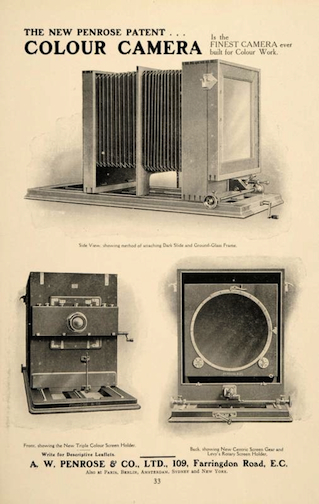
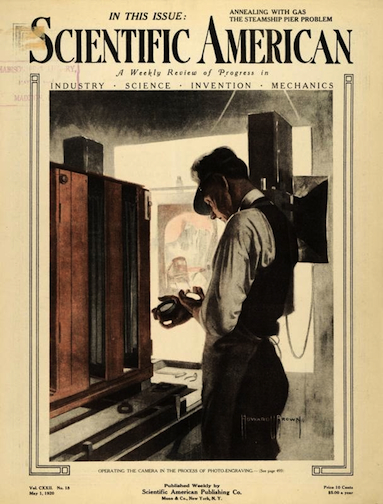

If you have or use one of these ultra large process cameras and would like to be added to this list then just send me an image and some text about yourself….
Hello!!
These are awesome! I recently acquired a Century No. 8, 11×14 Studio Camera. I shoot wet plate and am now able to shoot 14×14 plates. It had been sitting in the lobby of a portrait photographers studio in Philadelphia for 12 years collecting dust. I found it hard to believe the guy had it that long & never once made an image with it!
Thanks for sharing these beautiful pieces!
Matt
Hi Matt,
You got a pic of your camera, I’m always interested in seeing what others are using.
Thanks for stopping by the blog,
Tony
Thanks for sharing these beautiful cameras. I wish I could have found and bought one of those. Al least I was able to make my own ones.
I studied at the London school of printing 1959-61. I then worked for SrLittlejohn on those and more current cameras that you have displayed at their works in Brewery Road London. I spent all my working life using all different makes of process cameras until digital killed them off in the printing trade. Brings back fond memories
Great trip for me too,having worked for s r littlejohn 1963 1970
Bring back film, and glass plates ,and contact screens.
So much more to gain from the old days,skill for one.
Good to hear they are still being used.
Hi !! Great post , it was a lot inspiring reading this !! would be nice to be part of this list 😉 if you have a minute take a look at : http://www.lightcatcher .it thanks a lot !!! have a nice day kurt
Hi Kurt, I’ll add you when I get chance.
Thanks
Tony
I drove for 17hrs from Queensland to Victoria, Australia to pick up my second Hunter and Penrose process camera, and of course back again. I primarily shoot x-ray film just for the joy of it.(and its cheap film)
Just ordered some 14×17 inch xray film to shoot in my new four man portable H and p. It has been stored in a warehouse for forty years under canvas. I swapped a No4 century and stand plus a 4×5 mono and darkroom gear for it, bargain! Love your site!
Hi Andrew,
Lovely to hear from you.
Would love to see some of your work and some images of the camera.
My latest HP camera came with a load of half tone plates that might be interesting to shoot, pretty high contrast I’d imagine.
Have a great day,
Tony
i have an old piece of equipment that bears the S.R. littlejohn & co. London could someone please give some more information on S.R. Littlejohn
Hi Sean,
Plenty of info via Google.
Tony
I have an R.R. Robertson camera that is on Rails and is 62 in Long it looks like the other ones in the picture I found it and a home that I was refurbishing in St Louis Missouri. I’m not sure what to do with it if anybody has any advice I would be happy 2 here from you thank you.
Hi David
Good to hear from you. Any images of the camera? Do you have all the parts. Quite often the rear end is missing or the plate holders. If you measure the ground glass screen at the back of the camera (if it’s there) it’ll give people an idea of the plate size.
There always a healthy market for cameras but price can depend on quality, rarity and use.
Tony
hi I just bought a liitejohn process camera , im from uruguay , where can I Get more info , all the studio lights also
Does anyone know of photographs of the wonderful Littlejohn 24C vertical camera or knows if one still exists anywhere ? Likewise I’d love to hunt down a Littlejohn Magnacolour enlarger , surely the finest enlarger ever made . I operated process cameras all the way from wet plate to 4 colour direct screen and owned several including the above .
Hi David
I’ve never seen one. Victoria Museums, Australia seem to have an online image of a vertical Littlejohn process camera.
As for the enlarger, I’ll keep my eye open for you
Tony
Thank you Tony . Unfortunately that oz one doesn’t really fit the bill . Its one of Littlejohns cheaper range and wasn’t capable of 4 colour work .
It has amazed me that a whole industry using amazingly engineered cameras has completely disappeared . Same goes for all the scanners that superseded them especially as England pretty much dominated both the conventional and the electronic products with SR Littlejohn and Crossfield electronics both of whos products I once possessed in my company . Would be such a thrill to get my hands on one of those cameras / enlargers again . They cant all have been destroyed
Thanks again , I’ll keep looking
There must be some covered in dust in a lock up somewhere. Just a matter of time. Good luck.
hi im Jacques from uruguay ,I have 2 process cameras , one has a little John stand, one is a hunter -penrose,with a complete ;lightning set, I leave my email
Hi there, I have just been given a Little John camera similar to Peter Defty’s camera pictured in the blog, it is in a very sorry state but I hope to repair this to a high usable standard later this year. I am happy to send photos over if anyone is interested. I am also interested to know some history about the camera, what lens it would of had (as mine doesn’t have one) and if any one has a Little John I would love to see a working one to aid in my restoration.
Hi there, I have just bought a little John camera with is in a very sorry state as it had been out doors for 2 years, I have some pictures if people are interested, I am also intrigued in it’s history, what lens it would have had. If there is anyone out there who has a Little John camera I would love to see some images for reference when I restore my camera back to it’s former glory.
Hi Sam,
Always appreciate seeing people’s projects.
As far as I can remember, Penrose was bought by Hunter to make Hunter Penrose, who then bought out Littlejohn in the 60s?
Take a look for process lenses on eBay. Tend to start at f9 and up.
I bought mine for wet plate and it had no trouble taking huge wide open lenses.
Hi, we recently bought a sidney littlejohn repro camera.
We wonder what the function is of the inner metal frame is inside the back standard that can be moved back and forth. It looks like the metal frame in the plateholder. Hope someone can help us out.
Hi Nele,
If I remember rightly it’s for some sort of half tone? printing screen/filter. I’ll see if I can find the reference.
Where are you based and what size camera is it? Always interested in what people have what they are going to do with it.
Cheers
Tony
Hello Nele
Having operated a Hunter Penrose 30”X20” plate size process camera some 61 years ago (I can’t believe it either !) for litho reproduction I can tell you that the frame is referred to as the ‘screen gear’. It was used to grip (the horizontal bars are adjustable and have sloping edges) a glass half tone screen at a very precise distance from the glass ortho or pan plate. In my case that could be a “dry plate” by Ilford or a “wet plate” by, er, me. The brass screw at the base of the camera back adjusted (and could be locked) the distance and reads in mm’s. You will notice that moving the lever one way will bring the screen gear foul of the plate plane, so the gear would be swung inbound , the dark slide loaded and plate opened to the interior and the the screen gear swung back to the optimum distance for exposure. The image from the lens (I do hope yours is a Taylor Hobson) would project along the camera, hit the half tone screen and be broken up by the screen thus creating the dots of the half tone image. I can explain why a “screen distance” from the plate was necessary and what a half tone screen is but that may be far more than you wish to know and I can’t think how I’d do it without diagrams of the optics involved !
Hope that helps rather than further confuses. Enjoy your “Tram” , as we used to call them.
Hi Tony and David,
thanks a lot for your answers, and sorry for not having reacted yet.
We are Belgium-based, in Leuven, near Brussels.
Your reply confirms what we suspected, and we more or less understand what it is for, but always eager to learn about the screen gear from experienced experts like you, who actually used it as a reprocamera.
The camera we bought is a Littlejohn with serial number 1643 with a 21 inch Cooke apochromatic process lens. We have not found out yet how to upload some pictures here, otherwise we can share some.
We only very recently obtained the camera, so we haven’t tried it out yet.
Hi
Good to hear from you. Dont forget to swing that screen gear ‘in’ otherwise it’ll likely foul the darkslide.
David
Hi Nele,
I removed it from my camera as I was just using it for wet plate collodion, it was surprising how heavy it was.
If you email me some images I can add them to the blog post. tony@fourtoes.co.uk
What are your plans for yours?
Tony